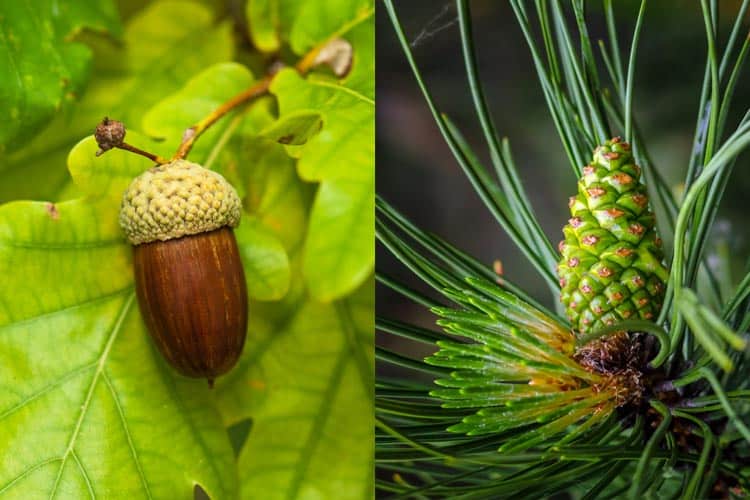Forest Stewardship: Gymnosperms vs Angiosperms

Gymnosperms and Angiosperms - How Different are They?
Winter sets in, we can see further through the woods, and the visual difference between our two big groups of trees comes into sharp relief. The “evergreens,” “needle trees,” “conifers,” or “softwoods” may be in dense pure stands, or they may be intermittent, peppering the woods with pockets of green winter foliage among the large swaths of trees that lose their leaves each fall – the deciduous trees, often referred to simply as the “hardwoods.” (And, of course, there are exceptions to the rule: larch or tamarack is a needle-bearing gymnosperm that sheds its foliage each year.) But is this way of grouping trees biologically accurate? Do the conifers have things in common with each other that differentiate them from the species that shed their leaves? Yes.
Eastern white pine and Canadian hemlock are by far the most dominant and common evergreens in the North Quabbin. There is some red pine, less and less each year, almost all of which were planted and tend to be concentrated on watershed lands and in state forests. There is some pitch pine too, although not much. Most of the spruce and fir in the NQ were probably planted, sometimes for Christmas trees, sometimes on public lands, like red pine.
All the pines, hemlocks, spruces, and firs are gymnosperms, one of the two main groups of spermatophytes, or seed plants. The second group, which includes the oaks, birches, maples, hickories, ashes and other familiar deciduous trees of the North Quabbin are angiosperms. Both groups produce seed, but the seed of angiosperms is enclosed within a fruit. The names are from Greek – gymnosperm meaning “naked seed,” angiosperm combining “vessel” and “seed”.
So what?Are there other differences that mean something, or is this just botanical minutiae?
The differences are indeed important, involving growth habit, reproduction, and competitive strategy. Gymnosperms are considered “less advanced,” having appeared about 300 million years ago, 200 or so million years before angiosperms. Despite being “recent,” angiosperms now account for about 90% of all plant species on land. Their big advance was the true flower, and everything associated with improved pollination, fertilization, seed and fruit development, leading to evolution of new species and the ability to colonize many different ecological niches.
Foliage and photosynthesis.
In retaining their leaves (needles) through the winter, conifers gain and lose:
- By not having to generate new foliage every year, they save resources;
- On the other hand, they risk desiccation under certain winter environmental conditions.
- Although some photosynthesis may take place during favorable winter conditions, this is probably less important than the early and late readiness factor. Conifers are able to begin photosynthesis early in the spring and extend the growing season in the fall if conditions are right because the photosynthetic apparatus is ready to go.
- By being present year-round, the foliage may be exposed for a longer time and damaged by some pests. When trees are very small, they may die if the foliage is eaten during the winter by animals desperate to find food.
- Snow and ice loads may be problematic for foliage-loaded crowns.
In dropping their leaves, angiosperms gain and lose as well:
- They must generate their full photosynthetic apparatus anew each year.
- They are exposed to some pests for less of the year. Although the next year’s growth is contained within buds, which may be browsed during the winter, some buds, especially at the base of small trees, are likely to escape browsing.
- Depending on the timing of flowering, pollen of some species (e.g., red maple) can travel greater distance without interference by leaves.
Gravity and light.
Have you noticed that the conifers seem to have (or keep) a strong single central stem more than the hardwoods? Massachusetts has many stands where white pine stems stand taller than the general level of the overstory. There are two reasons for this. First, white pine can continue to grow in height for many decades on a wide variety of sites. Secondly, white pines (and most other gymnosperms) have strong “apical dominance:” hormone flows are such that growth of the central stem is strongly prioritized over growth of lateral branches.
The elongating growing tips of gymnosperms have evolved to grow “geotropically” – with or against gravity. Angiosperms are different: they grow “phototropically” toward the light. This is considered an evolutionary advance and is pretty obvious once you start to look for it in or on the edge of the woods. Phototropism allows angiosperms to take advantage of light where it is available, rather than being limited to growing against gravity.
Fruiting structures and seed dispersal.
While both gymnosperms and angiosperms produce seed, the important difference is that angiosperms produce what we generally recognize as flowers, fruits and endosperm within the seed, which helps provide vital nutrition to a newly-germinated seed. With the evolution of a wide variety of fruit sizes and types, angiosperms have been able to disperse and reproduce spectacularly, aided by insects, wind, and a variety of animals (e.g., acorns, cherries, hickory nuts).
Vascular differences.
The only way that trees can get so big is by being able to move water, minerals and nutrients around the plant. In the most general sense, gymnosperms and angiosperms are alike in having xylem (water and minerals up) and phloem (photosynthates down). Angiosperms have a more sophisticated vascular system than gymnosperms, with more different and specialized cell types. You are probably familiar with the vessels of red oak, which are visible to the naked eye in the annual growth ring. The structure of the vessels is like a straw and allows for efficient movement of water from roots to the top of the tree. There’s much more to say about this, but that’s for another day.
